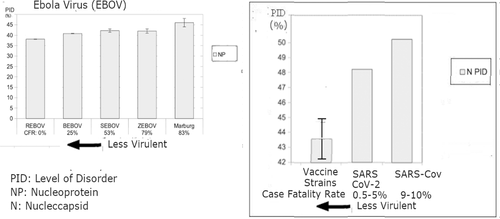当前位置:
X-MOL 学术
›
J. Proteome Res.
›
论文详情
Our official English website, www.x-mol.net, welcomes your
feedback! (Note: you will need to create a separate account there.)
A Novel Strategy for the Development of Vaccines for SARS-CoV-2 (COVID-19) and Other Viruses Using AI and Viral Shell Disorder
Journal of Proteome Research ( IF 3.8 ) Pub Date : 2020-10-02 , DOI: 10.1021/acs.jproteome.0c00672 Gerard Kian-Meng Goh 1 , A Keith Dunker 2 , James A Foster 3, 4 , Vladimir N Uversky 5, 6
Journal of Proteome Research ( IF 3.8 ) Pub Date : 2020-10-02 , DOI: 10.1021/acs.jproteome.0c00672 Gerard Kian-Meng Goh 1 , A Keith Dunker 2 , James A Foster 3, 4 , Vladimir N Uversky 5, 6
Affiliation

|
A model that predicts levels of coronavirus (CoV) respiratory and fecal–oral transmission potentials based on the shell disorder has been built using neural network (artificial intelligence, AI) analysis of the percentage of disorder (PID) in the nucleocapsid, N, and membrane, M, proteins of the inner and outer viral shells, respectively. Using primarily the PID of N, SARS-CoV-2 is grouped as having intermediate levels of both respiratory and fecal–oral transmission potentials. Related studies, using similar methodologies, have found strong positive correlations between virulence and inner shell disorder among numerous viruses, including Nipah, Ebola, and Dengue viruses. There is some evidence that this is also true for SARS-CoV-2 and SARS-CoV, which have N PIDs of 48% and 50%, and case-fatality rates of 0.5–5% and 10.9%, respectively. The underlying relationship between virulence and respiratory potentials has to do with the viral loads of vital organs and body fluids, respectively. Viruses can spread by respiratory means only if the viral loads in saliva and mucus exceed certain minima. Similarly, a patient is likelier to die when the viral load overwhelms vital organs. Greater disorder in inner shell proteins has been known to play important roles in the rapid replication of viruses by enhancing the efficiency pertaining to protein–protein/DNA/RNA/lipid bindings. This paper suggests a novel strategy in attenuating viruses involving comparison of disorder patterns of inner shells (N) of related viruses to identify residues and regions that could be ideal for mutation. The M protein of SARS-CoV-2 has one of the lowest M PID values (6%) in its family, and therefore, this virus has one of the hardest outer shells, which makes it resistant to antimicrobial enzymes in body fluid. While this is likely responsible for its greater contagiousness, the risks of creating an attenuated virus with a more disordered M are discussed.
中文翻译:

利用人工智能和病毒壳紊乱开发 SARS-CoV-2 (COVID-19) 和其他病毒疫苗的新策略
利用神经网络(人工智能,AI)分析核衣壳中的紊乱百分比 (PID)、N 和膜,M,分别是病毒内壳和外壳的蛋白质。主要使用 N 的 PID,将 SARS-CoV-2 归类为具有中等水平的呼吸道传播和粪口传播潜力。使用类似方法的相关研究发现,包括尼帕病毒、埃博拉病毒和登革热病毒在内的多种病毒的毒力与内壳紊乱之间存在很强的正相关性。有证据表明,SARS-CoV-2 和 SARS-CoV 也是如此,它们的 N PID 分别为 48% 和 50%,病死率分别为 0.5-5% 和 10.9%。毒力和呼吸潜力之间的潜在关系分别与重要器官和体液的病毒载量有关。只有当唾液和粘液中的病毒载量超过一定的最小值时,病毒才能通过呼吸道传播。同样,当病毒载量超过重要器官时,患者更有可能死亡。众所周知,内壳蛋白的更大紊乱通过提高蛋白质-蛋白质/DNA/RNA/脂质结合的效率,在病毒的快速复制中发挥重要作用。本文提出了一种减毒病毒的新策略,涉及比较相关病毒内壳(N)的无序模式,以识别可能适合突变的残基和区域。SARS-CoV-2 的 M 蛋白是其家族中 M PID 值最低的蛋白之一(6%),因此,该病毒具有最坚硬的外壳之一,这使其对体液中的抗菌酶具有抵抗力。虽然这可能是其传染性更强的原因,但我们还讨论了产生具有更无序 M 的减毒病毒的风险。
更新日期:2020-11-06
中文翻译:

利用人工智能和病毒壳紊乱开发 SARS-CoV-2 (COVID-19) 和其他病毒疫苗的新策略
利用神经网络(人工智能,AI)分析核衣壳中的紊乱百分比 (PID)、N 和膜,M,分别是病毒内壳和外壳的蛋白质。主要使用 N 的 PID,将 SARS-CoV-2 归类为具有中等水平的呼吸道传播和粪口传播潜力。使用类似方法的相关研究发现,包括尼帕病毒、埃博拉病毒和登革热病毒在内的多种病毒的毒力与内壳紊乱之间存在很强的正相关性。有证据表明,SARS-CoV-2 和 SARS-CoV 也是如此,它们的 N PID 分别为 48% 和 50%,病死率分别为 0.5-5% 和 10.9%。毒力和呼吸潜力之间的潜在关系分别与重要器官和体液的病毒载量有关。只有当唾液和粘液中的病毒载量超过一定的最小值时,病毒才能通过呼吸道传播。同样,当病毒载量超过重要器官时,患者更有可能死亡。众所周知,内壳蛋白的更大紊乱通过提高蛋白质-蛋白质/DNA/RNA/脂质结合的效率,在病毒的快速复制中发挥重要作用。本文提出了一种减毒病毒的新策略,涉及比较相关病毒内壳(N)的无序模式,以识别可能适合突变的残基和区域。SARS-CoV-2 的 M 蛋白是其家族中 M PID 值最低的蛋白之一(6%),因此,该病毒具有最坚硬的外壳之一,这使其对体液中的抗菌酶具有抵抗力。虽然这可能是其传染性更强的原因,但我们还讨论了产生具有更无序 M 的减毒病毒的风险。











































 京公网安备 11010802027423号
京公网安备 11010802027423号